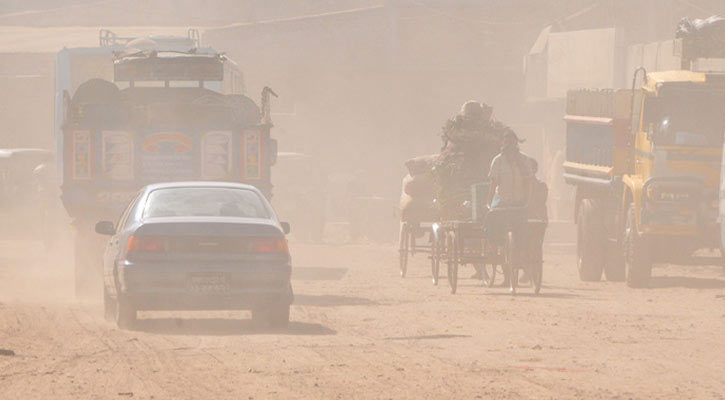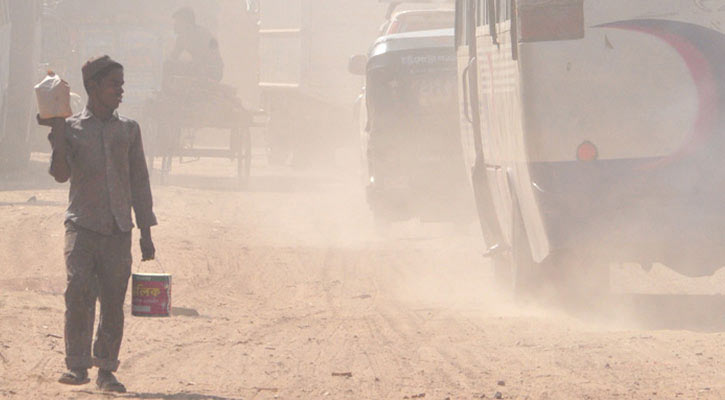Clean air and oxygen are essential for human survival. However, Dhaka—one of the most densely populated cities in the world—is currently facing severe air pollution and an oxygen deficit.
On one hand, widespread tree-cutting and relentless construction are underway across the city; on the other, the air is becoming increasingly hazardous due to dust, smoke, and toxic gases. As a result, city residents are exposed to serious health risks.
Dhaka covers an area of approximately 306 square kilometres and, according to the 2022 data from the Bangladesh Bureau of Statistics (BBS), has a population of around 10.3 million. It is the second-largest city in South Asia and ranks seventh globally by population. In terms of density, Dhaka is among the most congested urban areas in the world, with nearly 23,000 people per square kilometre.
Administratively, the city is divided into two parts: Dhaka North and Dhaka South City Corporations. Dhaka North spans approximately 196.22 square kilometres, while Dhaka South covers about 109.25 square kilometres. Together, the two corporations are divided into 129 wards—54 in the north and 75 in the south. Despite having more than 10 million residents, these areas lack the necessary greenery to provide an adequate supply of oxygen.
A 1917 urban plan had envisioned Dhaka as a "garden city." However, the pressures of unplanned urbanisation, housing demands, and rapid population growth have steadily erased the city’s green spaces, open fields, and water bodies.
Currently, there are only 48 parks and about 25 playgrounds of various sizes under the jurisdiction of the Dhaka city authorities. In many cases, these parks have become dysfunctional due to encroachment, neglect, or poor planning and management.
A 2020 tree survey conducted by the Bangladesh Forest Department and the United States Forest Service found that there are around 1.3 million trees in Dhaka City Corporation areas. Of these, 6,82,600 are located in Dhaka North and 6,16,900 in Dhaka South. This equates to only one tree for every seven residents.
Data shows that an adult human requires approximately 550 litres of oxygen daily. Based on that figure, Dhaka’s population of around 10 million needs approximately 5.5 billion litres of oxygen every day. However, the city’s existing trees can supply only 180 million litres daily—merely 3 to 5 percent of what is needed. The rest of the oxygen must come from outside the city, or from polluted sources and non-productive vegetation.
Air typically contains about 21 percent oxygen, and this level does not vary significantly between urban and rural areas. However, the key difference lies in the purity of the air. Urban air is often mixed with higher levels of dust, smoke, and toxic gases, making breathing more hazardous.
Causes of Pollution
Unplanned urban expansion, multi-storey buildings, markets, and indiscriminate construction of concrete structures are contributing to widespread tree cutting. This decline in greenery is directly affecting oxygen levels in the atmosphere.
A large number of illegal brick kilns and factories, particularly in and around Dhaka, emit black smoke laden with harmful particles such as PM 2.5, as well as toxic gases like carbon monoxide and nitrogen oxides. These emissions are seriously contaminating the city’s oxygen supply.
Another major contributor to oxygen pollution in Dhaka is the emissions from outdated and unfit vehicles. These vehicles release black smoke, nitrogen dioxide, and carbon monoxide into the air. Thousands of trucks and long-haul vehicles entering Dhaka daily, along with transboundary air pollution, further degrade air quality.
Waste management in the metropolitan area is also inadequate. Open dustbins, decomposing garbage in lakes, ponds, and drainage systems emit foul-smelling gases, adding toxins to the air.
Additionally, long-term road excavation and construction materials left on the streets contribute significantly to air pollution by increasing the concentration of airborne particles such as PM 10 and PM 2.5. These ultra-fine particles are the primary components of Dhaka’s polluted air and frequently place the city at the top of global pollution rankings. PM 2.5 and PM 10 refer to particulate matter that floats in the air and can enter human lungs, leading to various respiratory problems and posing long-term health risks.
Health Risks Worsen Amid Oxygen Crisis
The shortage of clean oxygen is pushing people toward a range of health hazards. According to the report titled The State of Global Air 2019, Bangladesh is one of only five countries where the entire population lives in areas exposed to polluted air. In terms of air pollution-related deaths, Bangladesh ranks fifth globally. In 2017 alone, air pollution caused the deaths of 1,23,000 people in the country.
A study by the Centre for Research on Energy and Clean Air (CREA) found that air pollution in Bangladesh leads to the premature deaths of 102,456 people each year, including 5,258 children. Additionally, air pollution is responsible for 900,000 cases of premature pregnancy and the births of approximately 700,000 underweight babies annually. Each year, around 670,000 patients are admitted to emergency departments due to pollution-related illnesses, resulting in the loss of an estimated 263 million workdays nationwide.
Research by the International Centre for Diarrhoeal Disease Research, Bangladesh (icddr,b) indicates that mothers exposed to high air pollution during pregnancy are significantly more likely to give birth prematurely and to underweight babies, compared to those exposed to lower pollution levels.
According to the National Institute of Preventive and Social Medicine (NIPSOM), cases of asthma and pneumonia in children have risen by 28 percent due to the lack of clean air. Among adults, risks of respiratory problems, high blood pressure, and heart disease have tripled. The working population is increasingly suffering from sleep disorders, mental fatigue, and depression.
The World Health Organization (WHO) reports that air pollution has led to rising death rates from stroke, heart disease, chronic obstructive pulmonary disease (COPD), lung cancer, and acute respiratory infections. Around 15,000 people die each year in Dhaka alone due to air pollution.
Dr. Md Riazul Islam, a consultant in asthma and respiratory diseases at Sir Salimullah Medical College and Hospital, said the lack of clean oxygen is causing pulmonary hypertension, acute respiratory distress, asthma, COPD, and cardiac complications. However, the highest number of hospital admissions daily is due to respiratory issues.
Asked about solutions to these health problems, Dr. Riaz suggested that densely populated areas must be systematically developed into planned residential zones. Factories within Dhaka should be made environmentally friendly. Extensive afforestation campaigns are essential. Strict enforcement of laws is necessary to eliminate black smoke from the capital. Only then, he said, can residents access clean oxygen and live healthier lives.
Dr. ATM Kamrul Hasan, a consultant in oncology at the National Institute of Cancer Research and Hospital in Mohakhali, stated that exposure to polluted air can lead to lung and bladder cancers due to carcinogens like lead and chromium present in the air.
He emphasized the need for action on three fronts—state, society, and individual. Individuals should use masks, avoid smoking, and consume nutritious food. Society must engage in reforestation through social movements, while the government should adopt strong anti-pollution programs. With coordinated effort, air pollution can be significantly reduced, he said.
Ways to Overcome Oxygen Crisis
In addition to the Dhaka City Corporations, schools, colleges, corporations, and citizens have a critical role to play in combating polluted air.
Tree planting should be made mandatory in abandoned areas, empty plots, and along roadsides. Occupied parks and fields must be reclaimed to expand open spaces. Ward-based afforestation programs and initiatives for park preservation must be implemented.
Laws requiring tree planting on every rooftop must be enforced. Incentives and tax breaks should be provided for rooftop gardening. Tree-planting campaigns should be introduced in schools to instil environmental awareness in children. Public awareness about air pollution must be increased.
In busy areas, shaded walkways and access to fresh air should be ensured. Burning plastic in open spaces, spreading dust, or excessive honking must be strictly prohibited.
To control waste and dust on roads, water-powered street cleaners should be widely deployed. Environmentally friendly vehicles should be introduced. Like industrialized countries, there should be plans to install “smart oxygen generators.”
Sharif Jamil, member-secretary of the environmental group Dhoritry Rokkhay Amra (DHORA), said an adult requires 550 litres of oxygen daily. Given Dhaka's massive population, the current level of greening is alarmingly insufficient. Trees alone cannot supply the required volume of oxygen as it comes from various sources, and its output varies depending on tree type and size.
He stressed that greening alone is not enough. Unless tree felling, industrial waste mismanagement, emissions from unfit vehicles, road dust, and brick kilns are properly controlled—and the urban heatwaves in the capital are reduced—the level of clean oxygen will not improve. Measures to curb air pollution will increase atmospheric oxygen. Along with inhaled oxygen, harmful substances like PM 2.5 enter the human body, causing significant damage to health, he warned.
The environmentalist further said that unplanned urbanisation and lack of good governance across regulatory bodies are key obstacles to environmental improvement. Institutions such as the Department of Environment, Bangladesh Road Transport Authority, and the Ministry of Industries, among others, are all suffering from governance deficiencies. “Ensuring good governance is not enough—we also need to think in terms of alternatives,” he said.
“For example, if you're trying to eliminate polythene from the market, you must also propose a viable substitute. Similarly, to control air pollution, we first need to identify its sources. Only then, through public participation, can we implement effective solutions. The government already possesses relevant data—on which areas are most polluted and the causes. The focus should be on using that data to take targeted action.”
When asked how green coverage could be increased, Sharif Jamil noted that there is virtually no open space left in Dhaka. However, the existing water bodies, parks, and gardens must be properly monitored and maintained. Wherever any open space is still available, it must be used for tree planting and reforestation.
“Clean air is a fundamental right,” he said. “If we cannot breathe clean air in our cities, then no matter how much development occurs, it will be destructive. Environmental protection is not just the government's responsibility—it is a collective duty. If we fail to act now, we will leave behind a toxic city for future generations, where clean breathing will become a luxury.”
“The time is now,” he added. “We must declare Dhaka a ‘tree-friendly city’ and take immediate steps to restore its natural environment.”
SMS/











